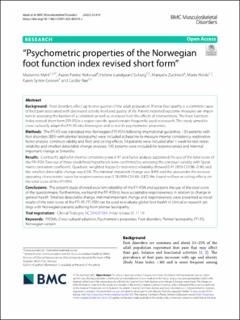| dc.contributor.author | Mørk, Marianne | |
| dc.contributor.author | Hoksrud, Aasne Fenne | |
| dc.contributor.author | Søberg, Helene L. | |
| dc.contributor.author | Zucknick, Manuela | |
| dc.contributor.author | Heide, Marte | |
| dc.contributor.author | Groven, Karen Synne | |
| dc.contributor.author | Røe, Cecilie | |
| dc.coverage.spatial | Norway | en_US |
| dc.date.accessioned | 2022-12-20T13:57:07Z | |
| dc.date.available | 2022-12-20T13:57:07Z | |
| dc.date.created | 2022-10-10T09:10:33Z | |
| dc.date.issued | 2022-05-03 | |
| dc.identifier.citation | BMC Musculoskeletal Disorders. 2022, 23 (1), 1-10. | en_US |
| dc.identifier.issn | 1471-2474 | |
| dc.identifier.uri | https://hdl.handle.net/11250/3038889 | |
| dc.description.abstract | Background: Foot disorders affect up to one quarter of the adult population. Plantar fasciopathy is a common cause of foot pain associated with decreased activity level and quality of life. Patient-reported outcome measures are important in assessing the burden of a condition as well as in research on the effects of interventions. The Foot Function Index revised short form (FFI-RS) is a region specific questionnaire frequently used in research. This study aimed to cross-culturally adapt the FFI-RS into Norwegian and to test its psychometric properties.
Methods: The FFI-RS was translated into Norwegian (FFI-RSN) following international guidelines. 139 patients with foot disorders (88% with plantar fasciopathy) were included at baseline to measure internal consistency, explorative factor analysis, construct validity and floor and ceiling effects. 54 patients were included after 1 week for test-retest reliability and smallest detectable change analyses. 100 patients were included for responsiveness and minimal important change at 3 months.
Results: Cronbach’s alpha for internal consistency was 0.97 and factor analysis supported the use of the total score of the FFI-RSN. Two out of three predefined hypotheses were confirmed by assessing the construct validity with Spearman’s correlation coefficient. Quadratic weighted Kappa for test-retest reliability showed 0.91 (95% CI 0.86–0.96) and the smallest detectable change was 6.5%. The minimal important change was 8.4% and the area under the receiver operating characteristic curve for responsiveness was 0.78 (95% CI 0.69–0.87). We found no floor or ceiling effects on the total score of the FFI-RSN.
Conclusions: The present study showed excellent reliability of the FFI-RSN and supports the use of the total score of the questionnaire. Furthermore, we found the FFI-RSN to have acceptable responsiveness in relation to change in general health. Smallest detectable change, minimal important change and responsiveness were presented as novel results of the total score of the FFI-RS. FFI-RSN can be used to evaluate global foot health in clinical or research settings with Norwegian patients suffering from plantar fasciopathy. | en_US |
| dc.language.iso | eng | en_US |
| dc.publisher | BMC | en_US |
| dc.relation.ispartofseries | BMC Musculoskeletal Disorders;23, Article number: 416 (2022) | |
| dc.rights | Navngivelse 4.0 Internasjonal | * |
| dc.rights.uri | http://creativecommons.org/licenses/by/4.0/deed.no | * |
| dc.subject | PROMs | en_US |
| dc.subject | Cross-cultural adaption | en_US |
| dc.subject | Psychometric properties | en_US |
| dc.subject | Foot disorders | en_US |
| dc.subject | Plantar fasciopathy | en_US |
| dc.subject | FFI-RS | en_US |
| dc.subject | Norwegian version | en_US |
| dc.title | “Psychometric properties of the Norwegian foot function index revised short form” | en_US |
| dc.type | Peer reviewed | en_US |
| dc.type | Journal article | en_US |
| dc.description.version | publishedVersion | en_US |
| dc.rights.holder | © The Author(s) 2022 | en_US |
| dc.source.articlenumber | 416 | en_US |
| cristin.ispublished | true | |
| cristin.fulltext | original | |
| cristin.qualitycode | 1 | |
| dc.identifier.doi | https://doi.org/10.1186/s12891-022-05374-x | |
| dc.identifier.cristin | 2059888 | |
| dc.source.journal | BMC Musculoskeletal Disorders | en_US |
| dc.source.volume | 23 | en_US |
| dc.source.issue | 1 | en_US |
| dc.source.pagenumber | 1-10 | en_US |

